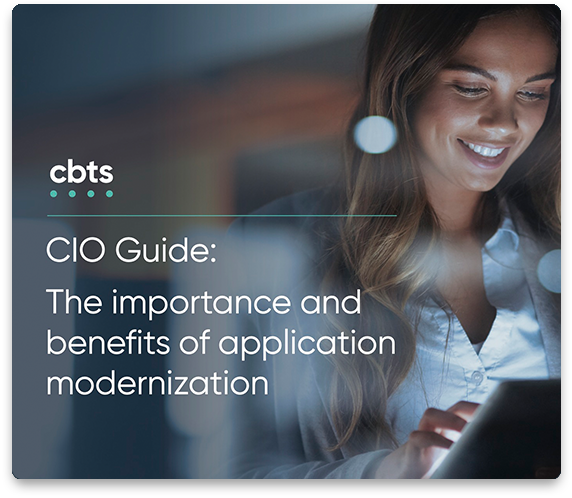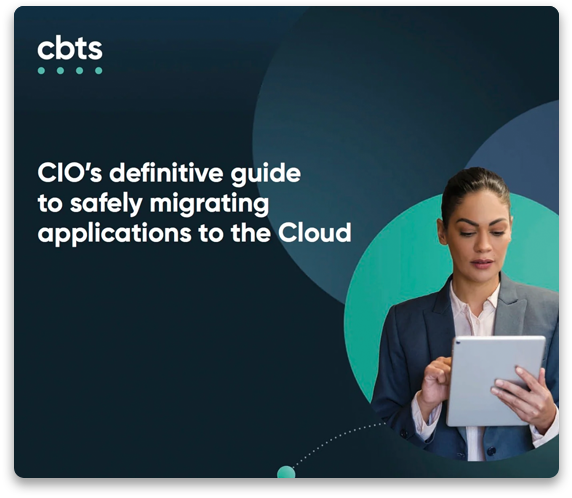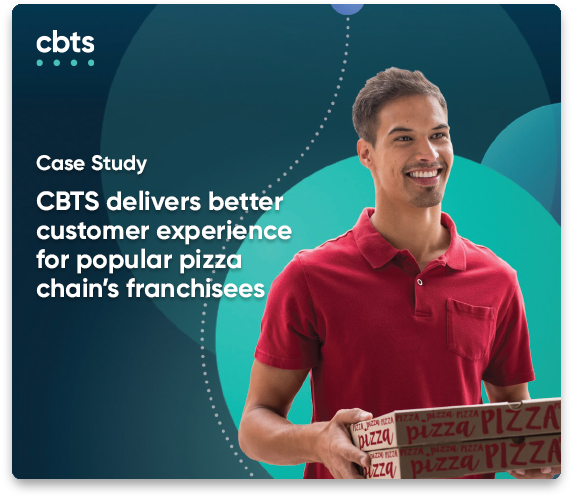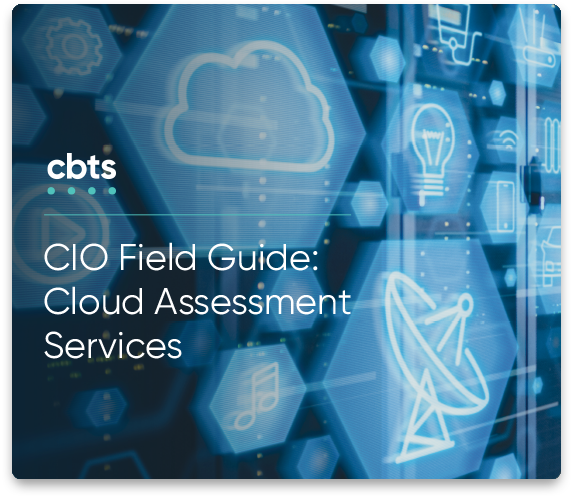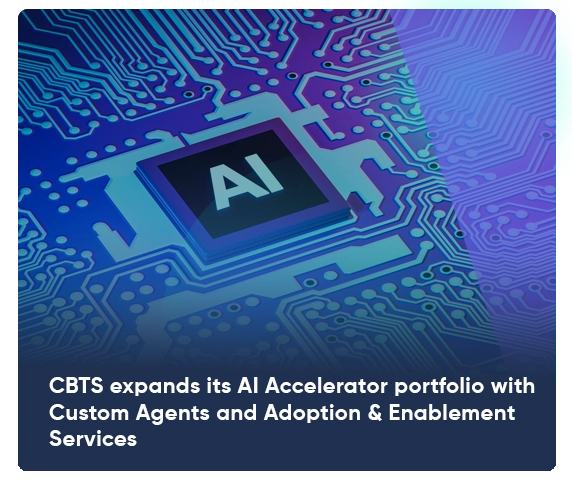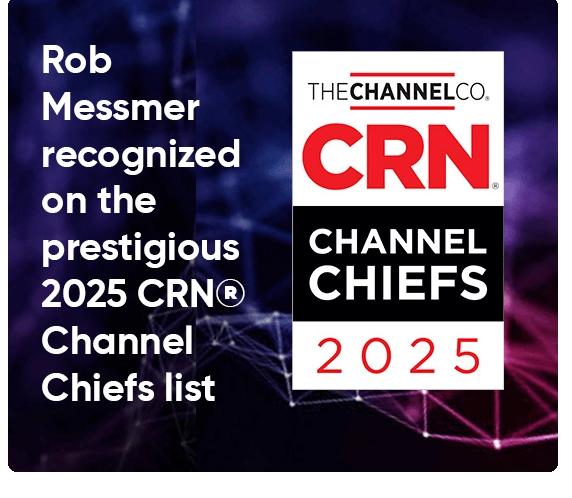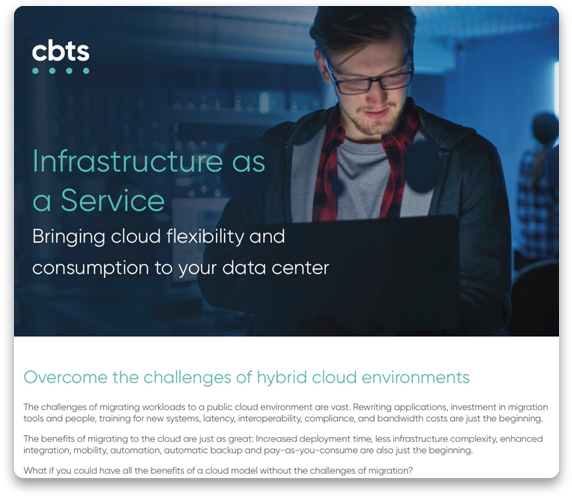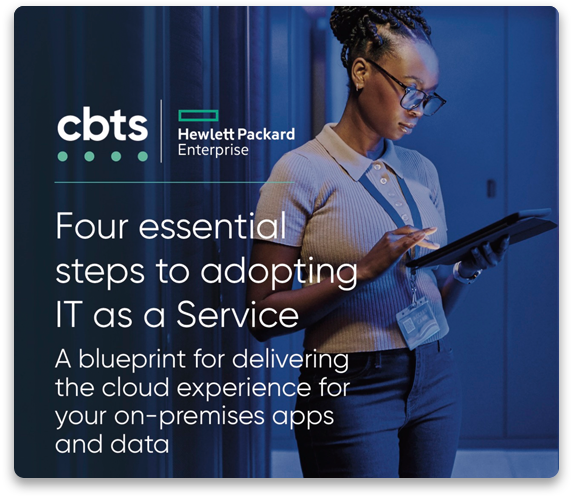IT Infrastructure Solutions
Create a secure, agile foundation.

Overview
Business outcomes
Solutions suite
Where to start
Methodology
FAQs
BUSINESS OUTCOMES
Aligning IT Infrastructure with business objectives
CIOs
Regain control of their organization’s hybrid environment through a unified dashboard.
DevOps
Faster deployment through simple point-and-click interfaces.
Without the burden of maintaining ITOps, your team can focus on innovation and prioritizing mission-critical activities. Clients benefit from CBTS infrastructure solutions by increasing scalability to meet demand and providing the ability to ramp up processes quickly using automation tools. Built-in security keeps your operations and supply chain partners fortified against malicious attacks.
SOLUTIONS SUITE
Our IT infrastructure solutions
WHERE TO START
Your ideas + our expertise = limitless possibilities
Not sure where to start?
Select the option that matches your business priorities.
Start here
Infrastructure hardware
CBTS provides solutions resilient to the needs of your business with a cloud operating and financial model.
Start here
Hybrid IT
CBTS Hybrid IT solutions combine public and private clouds into one cohesive environment.
Start here
Infrastructure as a Service
CBTS solutions allow for an OpEx consumption model with increased flexibility.
Start here
Network infrastructure
CBTS provides highly experienced, certified engineers to design custom network solutions in partnership with best-in-class technology providers.
Start here
Infrastructure security
CBTS will help you establish a more mature security posture with solutions that help you better identify and mitigate risks.
METHODOLOGY
Why CBTS?
CBTS experts help you unlock capital, boost operational and financial flexibility, and free up your talent to accelerate what’s next.
Assess
Perform a complete needs assessment covering data protection, network, database, firewall, backup recovery, and more.
Build
Build a strategy for implementation and migration across every phase of your infrastructure.
Transform
Modernize your IT infrastructure by migrating legacy technologies to the latest hardware and software.
Support
Deliver consistent, desirable outcomes through long-term management, support, and services.
Security is a significant concern for infrastructure because it often falls to the strained IT department. Fortunately, CBTS utilizes next-gen security protocols, including Firewall as a Service (FWaaS), advanced threat protection (ATP), and security operations center (SOC) services to secure Platform as a Service (PaaS) solutions. Users can rest easy knowing their data and systems are well-guarded.

“Our Infrastructure solutions practice is centered on helping clients become efficient, optimized, and agile to achieve their business goals. Best of all, when we are in the thick of it and advocating for our clients, we develop strong, long-lasting relationships.”
– Steve Lankard, Vice President & Principal – Infrastructure Solutions
Case studies
View All
The client is a global medical products company headquartered in Cincinnati, with offices in Chicago, Rome, Paris, and other European offices.
Problem
After splitting from its parent company to merge with a private equity firm, the client needed a partner to build its entire IT infrastructure while minimizing expenses quickly. The complete solution’s components must include networking, voice, wireless, mobile phones, and helpdesk for all locations and remote employees.
CBTS solution
The client hired CBTS and requested a proposal within one week. CBTS mobilized resources and presented a solution to host the network core in a local data center and utilize CBTS Infrastructure as a Service (IaaS) or virtual data center (VDC) for applications. The client awarded the project to CBTS after two weeks, and implementation started immediately. Within four weeks, the CBTS Infrastructure team set up the entire IT infrastructure and launched successfully.
Outcome
In seven weeks, CBTS built a fully operational, state-of-the-art IT infrastructure from the ground up, allowing the company to avoid the costly expense of a transitional service agreement (TSA). The quick turnaround saved the spin-off thousands of dollars in IT-related costs.
The client, a comprehensive securities group comprising 30 companies, provides a wide range of services centered on the core businesses of retail, global wholesale, asset management, and global investment banking.
Problem
The client faced challenges with HPE C7000s reaching end of sale (EOS). They tested various technologies in labs, ultimately choosing HPE Synergy after an executive briefing.
CBTS solution
CBTS engaged the client in consultative services and set up a live demo in the client’s environment. An ROI analysis was completed and proved instrumental in the decision to move forward. During the executive briefing, the client decided on HPE Synergy to leverage the software-defined infrastructure for physical, virtual, and containerized workloads and OneView for ease of management.
Outcome
The client participated in the HPE buy-back program, freeing the budget to refresh its data center, update storage, implement new e-mail servers, and purchase all licensing, services, and training. The HPE Synergy implementation achieved the 90% virtualized workload target with an exponential increase in memory and processing speed, application deployment, and overall performance. Its IT resources can now focus on strategic initiatives by implementing HPE OneView with workflow orchestration and management.
The client, a higher education organization, serves thousands of students, faculty members, and researchers through a network of facilities.
Problem
The client needed a robust network to support students with an average of seven connected devices each. Its aging network and wireless infrastructure caused complaints from users and lacked guest access. Furthermore, the IT organization needed more bandwidth to maintain and upgrade the network.
CBTS solution
CBTS Infrastructure services helped the client improve connectivity, security, and flexibility. We performed surveys, updated network closets, and installed new technology for reliable connections. Additionally, CBTS implemented ClearPass software for secure access with multiple smart devices.
Outcome
After implementing the custom solution, CBTS Infrastructure achieved remarkable outcomes for the client. The network now boasts industry-leading access and upload and download speeds, ensuring an outstanding student experience. The guest network provides secure connectivity to the university network. Moreover, the client benefits from a fully managed network solution, freeing up its IT team to focus on strategic initiatives.
The client is a large, complex healthcare organization navigating transformational change due to ongoing consolidation in the industry.
Problem
The client’s IT department faced challenges with aging and disparate infrastructure. Scaling opportunities were limited, leading to downtime for critical applications. Due to the organization’s infrastructure issues, they could not focus on value-added digital initiatives for improving patient care.
CBTS solution
The client engaged CBTS Infrastructure to analyze its environment and create a phased roadmap to support organizational goals. A deep dive identified pain points and future IT needs. Recommendations included high-performance computing storage, a converged infrastructure (CI) solution based on FlexPod, automation with VMware vCloud Suite, and Disaster Recovery as a Service. CBTS implemented the project, addressing each client issue and providing the foundation for future growth and innovation by freeing IT resources with remote monitoring and management.
Outcome
CBTS Infrastructure became a trusted advisor to the client’s CIO, delivering a validated business case identifying benefits and risks for infrastructure improvements and increased bandwidth to support business and patient care initiatives.
Continue your journey
FAQs
Top 5 questions
What is network infrastructure?
The hardware, software, security, and network services that enable connectivity, communication, and task completion through devices, applications, the Internet, and other services.
What is Hybrid IT?
Hybrid IT is an approach to managing some IT resources in-house and with cloud-based services for others. This virtualized hardware and storage can be rented from an infrastructure provider.
What is IaaS?
Infrastructure as a Service (IaaS) is a cloud computing service allowing companies to outsource computing, storage, and networking resources on demand.
What is PaaS?
Platform as a Service (PaaS) is a cloud computing model using a third-party provider’s hardware and software tools.
Why should I consider IT infrastructure services?
Even the most capable in-house IT teams face challenges continuously maintaining their data centers, hardware, and networking.
Related stories
Schedule a complimentary 30-minute discussion
with a CBTS solution consultant.
Talk to one of our experts today to see how we can help your organization virtualize its IT operations and convert IT spending into an operating expense.

